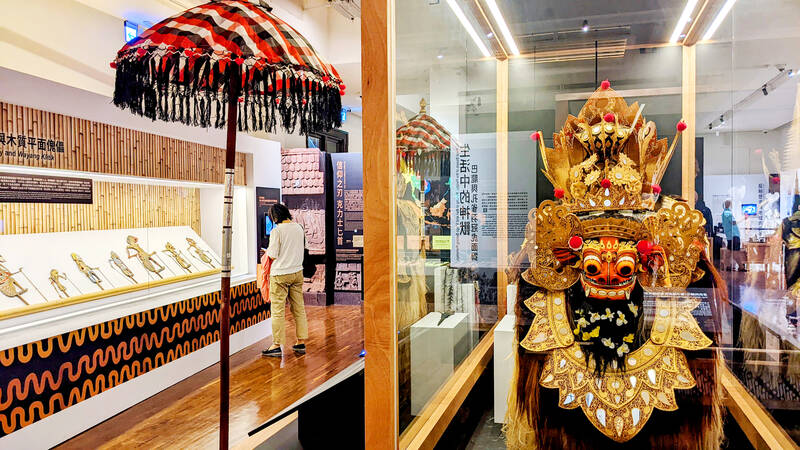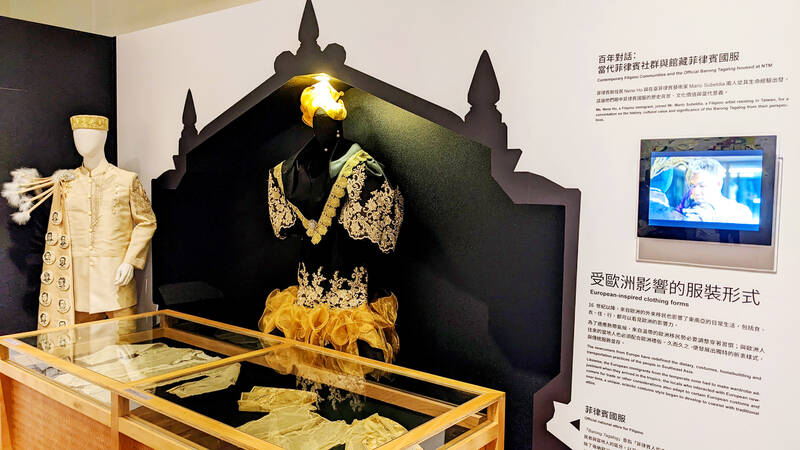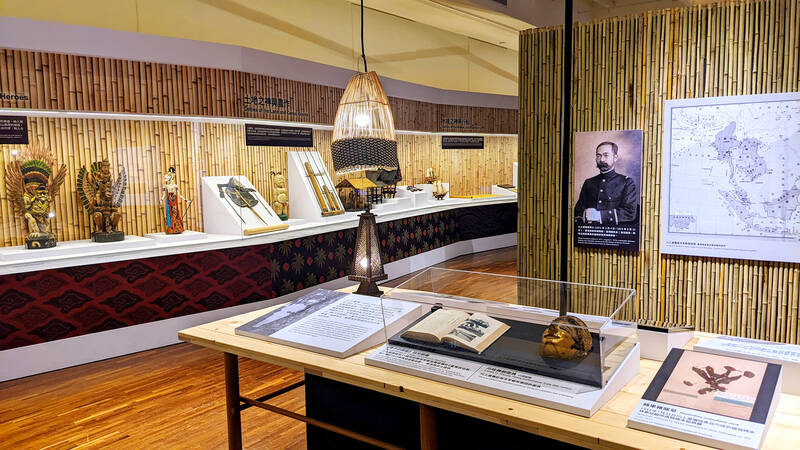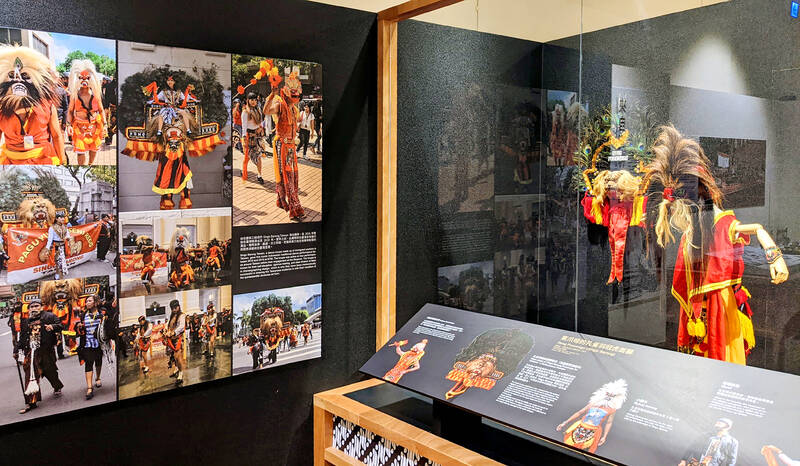Like many Indonesians in Taiwan, this exhibition’s majestic, lion or panther-like Barong is a recent transplant. Arriving in 2014 from Bali, the colorful creature was commissioned by the Indonesian Economic and Trade Office for traditional dance performances until it joined the National Taiwan Museum’s permanent collection five years later.
The Barong is an impressive showpiece on it’s own, but the museum’s new “A Centenary Dialog: When Transnational Migrants and Museum Collections Cross Paths” (百年對話:跨國移動者與藏品的相遇) exhibit goes beyond just its Southeast Asian artifacts and their countries of origin. Their connections to Taiwan via the migrants and immigrants here is a significant part of the presentation — for example, along with a historic video of the Barong dance in Bali are photos of performances in Taiwan, as well as information on how Taiwan-based Balinese artists crafted a new Barong after this one went to the museum.
The audience also hears directly from members of the cultures that produced these objects, and while the museum does interview experts, it also includes the voices of ordinary people talking about what these traditions mean to them. It doesn’t have to be something academic or profound; some simply express how the artifact reminds them of home and how happy they are to be able to see it here.

Photo: Han Cheung, Taipei Times
“It’s the most iconic form of performing arts in my home. I grew up watching the show!” a migrant worker from East Java says of the wayang klitik puppets. “I was thrilled when I saw them.”
This is a very refreshing way to exhibit cultural objects that should be employed more often, as it not just gives a voice to them, but provides meaningful, tangible context for people to connect. These are not just objects from a faraway land; visitors can find out when the next Barong performance in Taipei is and experience it themselves.
Such treatment is also crucial as it contributes to the effort by migrant advocacy groups in encouraging mutual understanding between Taiwanese and the hundreds of thousands of Southeast Asians migrants and immigrants. An entire section focuses on those who have been tirelessly helping the museum promote and explain their culture to locals, and they will be leading family-oriented workshops over the next month that include Barong dancing, dagger-making and other crafts.

Photo: Han Cheung, Taipei Times
In addition to the Chinese and English displays, visitors can scan a QR code to read the text in Indonesian, Vietnamese and Thai.
This exhibit is a great example of “returning” displays to its people while still maintaining the authoritative knowledge of the institution. Interestingly, this inclusivity could only be accomplished today, as many objects were collected during the Japanese era when there were few Southeast Asians in Taiwan to speak about them.
Former museum director Takiya Kawakami was one of the scholars fascinated with the region, embarking on a 11-month botanical expedition between 1911 and 1912. In addition to his field research, he brought back many artifacts and penned the travelogue The Canopy of Coconut Trees, an original copy of which is displayed at the beginning of the exhibition.

Photo: Han Cheung, Taipei Times
The religious and ritualistic sections, including masks, keris daggers, musical instruments and puppets are the highlights, while the last room sums up clothing, food, housing and other essentials.
There’s definitely an emphasis on Indonesia and to a certain extent the Philippines, and it would be nice to hear more from other groups such as the Vietnamese, who also have a significant presence in Taiwan. But overall, it’s a well-organized, easily navigable showcase that visitors should take their time browsing through.
If you have time afterward, the Monsters: An Exhibition of Aquatic Reptile Fossils (水怪-水棲爬行動物化石展), which opened in June and runs until May next year, is also quite atmospheric and fascinating.

Photo: Han Cheung, Taipei Times

Nine Taiwanese nervously stand on an observation platform at Tokyo’s Haneda International Airport. It’s 9:20am on March 27, 1968, and they are awaiting the arrival of Liu Wen-ching (柳文卿), who is about to be deported back to Taiwan where he faces possible execution for his independence activities. As he is removed from a minibus, a tenth activist, Dai Tian-chao (戴天昭), jumps out of his hiding place and attacks the immigration officials — the nine other activists in tow — while urging Liu to make a run for it. But he’s pinned to the ground. Amid the commotion, Liu tries to

The slashing of the government’s proposed budget by the two China-aligned parties in the legislature, the Chinese Nationalist Party (KMT) and Taiwan People’s Party (TPP), has apparently resulted in blowback from the US. On the recent junket to US President Donald Trump’s inauguration, KMT legislators reported that they were confronted by US officials and congressmen angered at the cuts to the defense budget. The United Daily News (UDN), the longtime KMT party paper, now KMT-aligned media, responded to US anger by blaming the foreign media. Its regular column, the Cold Eye Collection (冷眼集), attacked the international media last month in

A pig’s head sits atop a shelf, tufts of blonde hair sprouting from its taut scalp. Opposite, its chalky, wrinkled heart glows red in a bubbling vat of liquid, locks of thick dark hair and teeth scattered below. A giant screen shows the pig draped in a hospital gown. Is it dead? A surgeon inserts human teeth implants, then hair implants — beautifying the horrifyingly human-like animal. Chang Chen-shen (張辰申) calls Incarnation Project: Deviation Lovers “a satirical self-criticism, a critique on the fact that throughout our lives we’ve been instilled with ideas and things that don’t belong to us.” Chang

Feb. 10 to Feb. 16 More than three decades after penning the iconic High Green Mountains (高山青), a frail Teng Yu-ping (鄧禹平) finally visited the verdant peaks and blue streams of Alishan described in the lyrics. Often mistaken as an indigenous folk song, it was actually created in 1949 by Chinese filmmakers while shooting a scene for the movie Happenings in Alishan (阿里山風雲) in Taipei’s Beitou District (北投), recounts director Chang Ying (張英) in the 1999 book, Chang Ying’s Contributions to Taiwanese Cinema and Theater (打鑼三響包得行: 張英對台灣影劇的貢獻). The team was meant to return to China after filming, but